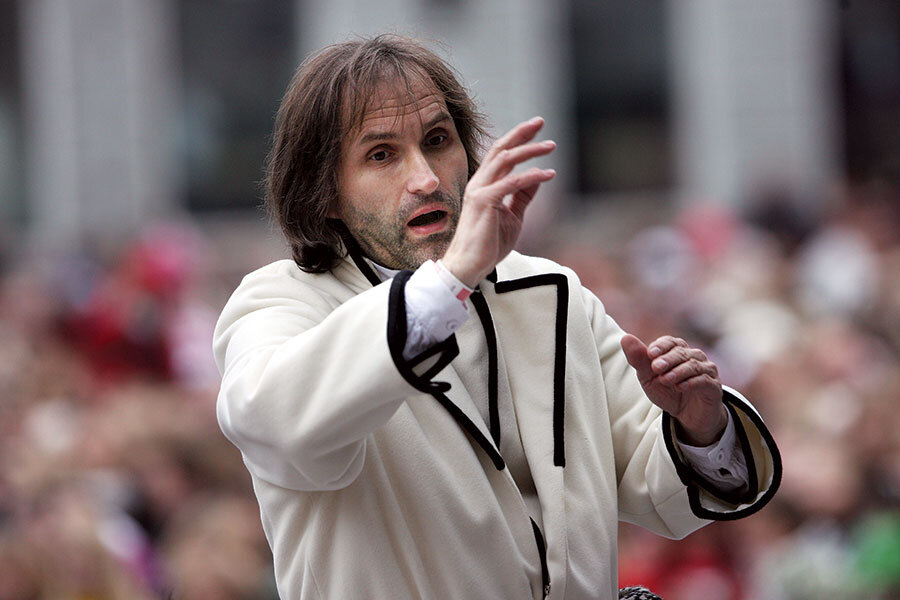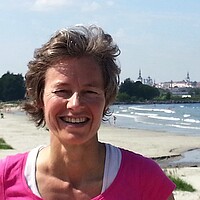Aarne Saluveer helps meld an alienated Russian minority into Estonia’s culture
Loading...
| NARVA, ESTONIA
On a recent spring day in Rugodiv auditorium in Narva, a city on Estonia’s eastern border with Russia, 280 children are singing: “This is what I hear/ This is what I see/ This is what I feel/ This is my homeland.”
Standing shoulder to shoulder, they all sing in Estonian, a surprise in this Russian enclave of 58,600 on the dividing line between the European Union and the Russian Federation. Once a thriving manufacturing center in Soviet times, Narva has become one of Estonia’s most depressed and forgotten corners. At home, most of the children still speak Russian.
But on this day the children sing in Estonian about identity, and about what they like and do not like about the country they live in. “My country is beautiful, and ugly, too,” they sing, their voices rising high in beautiful harmony.
Their conductor, Aarne Saluveer, is on a mission here: to bring Estonia’s Russian- and Estonian-speakers together the way he knows best, through song.
A well-known singer and keyboard player in Soviet times, Mr. Saluveer now heads the Georg Ots Music College in Tallinn, Estonia’s capital. As he hops down from the stage, he looks his young singers in the eye: He has a talent for making each singer feel as if he or she is being spoken to directly. Conversing now in Russian, now in Estonian, both with ease and comfort, he gets to the core of what the song “Minu Isamaa,” or “My Homeland,” which he crafted together with a composer and lyricist, is all about.
The history of every society, he tells them, includes both good and bad things: Estonia’s does. Russia’s does. “We could have less arrogance and fewer wars if we could only learn from history,” he says.
Every five years since 1869, Estonians have come together around a unique choral event called Laulupidu. This year more than 33,000 singers performed for an audience of 153,000. Laulupidu has been a force for helping this country of 1.3 million endure occupation and oppression. In 1988, defying their Soviet rulers, half a million Estonians sang a forbidden hymn in a peaceful “singing revolution” that helped bring down communism here.
Most Estonians feel emotionally attached to Laulupidu. But for a long time, many Russian-speakers had never even heard of it. For them, the singing revolution ended badly: They lost the favored status they’d had when Estonia was part of the old Soviet Union. In independent Estonia, many felt like a disliked minority and part of Estonia’s underclass.
From the banks of the Narva River here one can see the Russian flag waving from Ivangorod, a medieval fortress across the river 84 miles from St. Petersburg, Russia.
The simmering mistrust between Estonia’s Russian- and Estonian-speakers played out right here in Narva, Estonia’s third largest city. In 1944, the Soviet Army pushed the German Nazis out. But the Soviet victory heralded a dark chapter of Soviet occupation. Most of Narva’s Estonians were displaced – many perished in Siberian labor camps – and were replaced by workers from other Soviet satellite states.
In 2007, the removal of a Soviet-era war memorial from the center of Tallinn triggered violent rioting among Estonia’s Russians. Relationships have normalized somewhat since, and many younger Russian-speakers have become very successful, but politicians still “play with the Russian votes and use the national card during the elections,” says film director Alyona Surzhikova, whose parents came from Uzbekistan and Ukraine, two former Soviet states.
Today Narva remains a place apart.
“It’s like Russia,” Ms. Surzhikova says. In her film “Not My Land,” she focuses on Russian-speakers’ perception of living in post-communist Estonia.
Meanwhile, Narva officials say that only recently, with the Ukraine crisis, have Estonia’s politicians started coming to Narva and paying attention to its Russian-speakers.
A quarter-century after the Soviet Union crumbled, the challenge of sewing up the rifts between Estonia’s Russian-speakers and the rest of Estonia remains one of the most emotionally charged – and important – issues of the post-Soviet era.
On July 5-6, about 500 Russian-speaking children from the Narva region joined the highly competitive Laulupidu event singing “My Homeland” along with 7,500 Estonian children. As they joined in singing “Land of my fathers, land that I love,” they moved a little closer to adopting Estonia as their own.
“What Aarne is doing is very important, and he is successful,” says Valeri Jääger of the Rugodiv cultural center in Narva.
“Twenty years ago it would have been unthinkable for children in Narva to sing about how beautiful a land Estonia is,” Mr. Jääger says. His own mother came from Leningrad (today St. Petersburg) to work at Narva’s Kreenholm textile factory, which had 13,000 workers in Soviet times but has since gone bankrupt.
In the early 1990s, a group of Russian-speakers plotted Narva’s secession from Estonia. There was little place for an Estonian national event like Laulupidu.
“But now it’s become a huge goal to get to the song festival,” Jääger says. “Parents know that it helps to learn Estonian to get on with life. It’s very important because it allows Russian-speaking people to accept the song festival as their own.”
Saluveer is playing his part in the reconciliation effort. “Aarne has charisma, and he has a vision,” says Laine Randjärv, a former culture minister who was born in Moscow. “When he says, ‘You all come with me,’ people do go with him.”
Back in the early 1980s, the Soviet Army gave Saluveer a choice: Go fight in Afghanistan or teach music. That’s how, at age 20, he came to work in a school near Tallinn, home to the Soviet Baltic submarine fleet. In Soviet times the popular band he started was required to perform hundreds of times a year in Estonia and in cities across the former Soviet Union from Moscow to Odessa.
“But I didn’t like being a puppet of the Soviet Union,” he recalls. He did manage to record a song called “Silently,” which “is about inner feelings, about the fact that most things in life happen inside your heart.”
One day, he says, children will sing it at Laulupidu.
Focusing attention on Estonia’s Russian-speakers is important because it breaks down stereotypes, says Katri Raik, president of Tartu University’s Narva College, whose new building is often dubbed “Narva’s Estonian embassy.” “When Aarne Saluveer goes to Narva, others will want to come, too,” she says about the conductor who’s been named musician and conductor of the year several times in Estonia. “In such a tiny little country like ours, role models are important.”
Saluveer’s main asset is his conducting style, Jääger says. “Aarne is successful because he is able to communicate well. He’s got a repertoire that touches current issues, not just traditional old songs.”
“When he is in front of children, he’s like a big child who wants to play, and all the children feel it,” says Tauno Aints, who composed the music for “My Homeland.”
Saluveer always seems to be in motion, his brown shoulder-length hair waving. He disagrees when people say children should only sing “children’s songs.”
The song festival “is a holy event,” he says, with an earnest look in his eyes. “This is not your voice which is singing. This is your mind.” At one point he asks his young singers, “What is the best part about your country?” One answers in Russian. Another in Estonian.
Music fills the gigantic auditorium. Jazz. Rock. String quartets. Opera. A cappella singing. “There are lots of sounds in the world,” Saluveer says.
Estonian Maris Hellrand says she felt “overwhelmed” recently when she listened to the Narva children sing “My Homeland.”
“They were really open in sharing their emotions,” she says. It might seem difficult for Russian-speaking children to sing the praises of Estonia, but Saluveer helps them “understand that it’s acceptable not to like everything,” she says.
“The kids listen to him. I’m convinced that those kids in Narva, having them participating in Laulupidu, are our strongest guarantee of security.”
How to take action
Universal Giving helps people give to and volunteer for top-performing charitable organizations around the world. Projects are vetted by Universal Giving; 100 percent of each donation goes directly to the listed cause. Below are groups selected by Universal Giving that help people worldwide through the arts:
• Volunteers For Peace promotes voluntary service projects. Take action: Volunteer to aid children through arts or other educational projects throughout Europe.
• Children of Uganda supports and empowers orphans and vulnerable children in Uganda. Take action: Donate to the Tour of Light, a musical tour that raises funds for health and educational aid to underprivileged children in Uganda.
• The GVN Foundation offers volunteer opportunities in 17 countries. Take action: Volunteer in a Costa Rican orphanage teaching music, arts, or other subjects.








